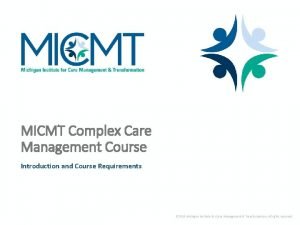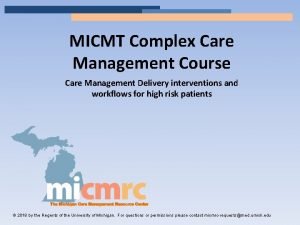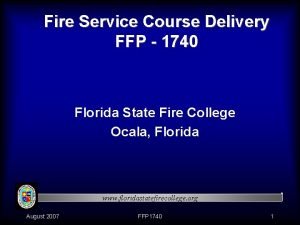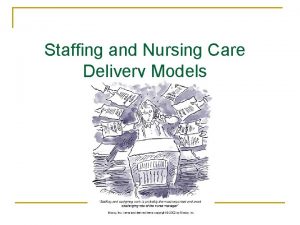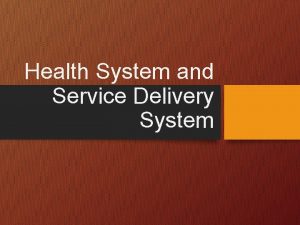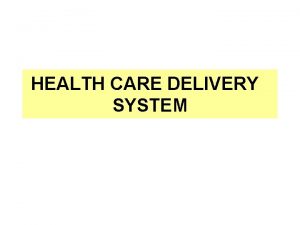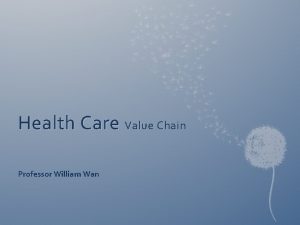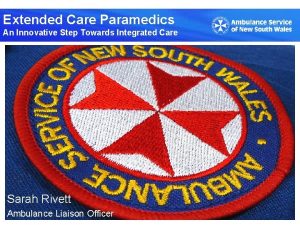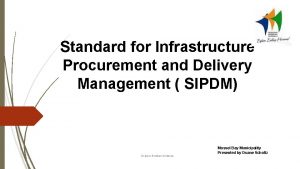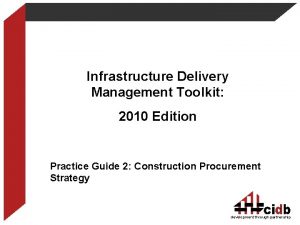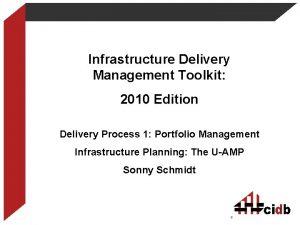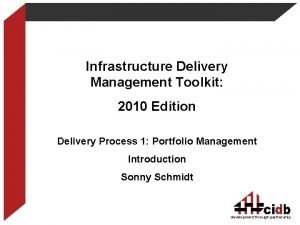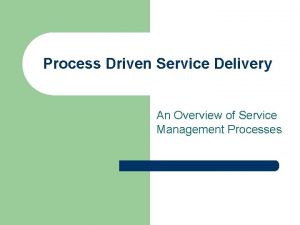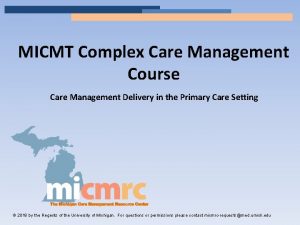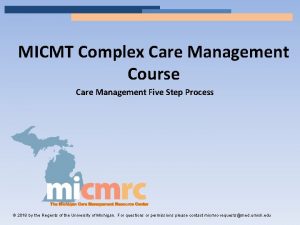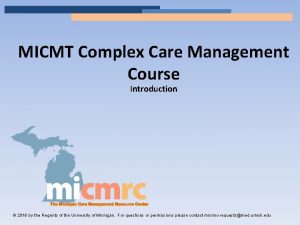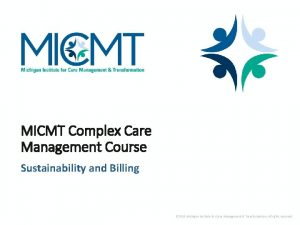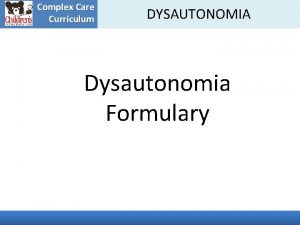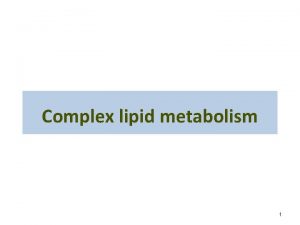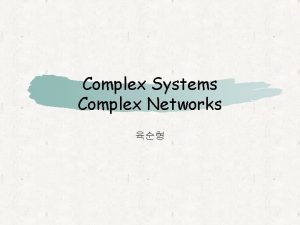MICMT Complex Care Management Course Care Management Delivery



























- Slides: 27

MICMT Complex Care Management Course Care Management Delivery interventions and workflows for high risk patients © 2018 by the Regents of the University of Michigan. For questions or permissions please contact micmrc-requests@med. umich. edu

Learning Objectives • Summarize effective transitions of care processes in the primary care setting • Describe a workflow, which is a collaborative approach, to address chronic conditions with the aim of reducing hospital readmissions 2

Transition Management: The processes of care coordination and transition management necessitate professional assessment, patient risk identification and stratification, and identification of individual patient needs and preferences that require: • Interprofessional collaboration and teamwork • Evidence-based care delivery • Patient and/or caregiver activation and empowerment • Utilization of quality and safety standards • Ability to assess and respond to resource needs 3

Focus in Primary Care • Utilize transition assessment to: – Identify barriers/reasons for increased ED/hospital visits – Aid in medication reconciliation and medication management – Determine risk level of patient – Determine patient’s ability to self-manage – Ensure patient is scheduled for follow up appointments and has resources to follow through – Ensure that discharge instructions are understood by the patient and the patient is able to follow and teach back – Identify SDOH needs of the patient 8

Post Hospitalizations: Prioritization of High Risk Patients based on Risk of Readmission High-Risk Patients Moderate-Risk Patients Low-Risk Patients Patient has been admitted two or more times in the past year Patient has been admitted once in the past year Patient has had no other hospital admissions in the past year Patient is unable to Teach. Back, or the patient or family caregiver has a low degree of confidence to carry out self-care at home Patient or family caregiver has a moderate degree of confidence to carry out self -care at home, based on Teach Back results Patient or family caregiver has high degree of confidence and can Teach. Back how to carry out selfcare at home http: //www. ihi. org/resources/Pages/Tools/Howto. Guide. Improving. Transitionsfrom. Hospitalto. Home. Health. Care. Reduce. Avoidable. H ospitalizations. aspx 9

Rising Risk • Each year, about 18% of rising-risk patients escalate into the high-risk category when not managed. 10

LACE tool • L - Length of hospital stay • A - Acuity of admission • C- Comorbidities • E - Emergency Department visits Evidence based tool to stratify patients at high risk for hospital readmission https: //www. ncbi. nlm. nih. gov/pmc/articles/PMC 5374974/ 11

https: //micmrc. org/topics/transitions-of-care Della Slavsky RN, BSN, BA Mi. PCT Clinical Lead Upper Peninsula Health Plan Janet Pund BSN, RN-BC Mi. PCT Clinical Lead University of Michigan Health System 12

https: //www. integration. samhsa. gov/workforce/teammembers/Cambridge_Health_Alliance_Team-Based_Care_Toolkit. pdf 13

https: //www. integration. samhsa. gov/workforce/teammembers/Cambridge_Health_Alliance_Team-Based_Care_Toolkit. pdf 14

Transition Management Should Include: • Stronger team knowledge of patient care transitions • Effective inclusion of the patient as a member of the team by eliciting patient goals and educating the patient on self-management • The efficient provision of a reconciled medication list for the patient, family members, caregivers, and home health staff • Enhanced communication with hospital discharge teams and care coordination supports from local hospitals Ø Medication management in particular is a mainstay of reorganized patient care transitions, and it is an area in which patient-centered care with physician-led teams is demonstrating an impact. Ø Special attention is needed for patients who are repeat ED users as they demonstrate a greater correlation with SDOH. Khanna, N. , Shaya, F. T. , Chirikov, V. V. , Sharp, D. , Steffen, B. Patient-Centered teamwork in care transitions, (2015, June). The American Journal of Accountable Care 16

Transition Management Risk Level LOW RISK Engaged patient with COPD who is self managing symptoms MODERATE RISK Patient with low blood sugar episode related to SDOH needs, (food inadequacy, housing instability) RISING RISK HIGH RISK Over weight pre-diabetic patient with A 1 C Poorly controlled diabetes and heart of 5. 8 and low health literacy failure, 3 admissions and 2 ER visits over the last 6 months * All patients recently discharged 17

Transition Management and Team • Successful care transitions rely on multiple providers, including – physicians, nurses, care managers, pharmacists, medical assistants and social workers, among others, to deliver coordinated care across an array of settings. • Each team member must be engaged in care transitions and actively fulfill his or her roles in order for the program to result in improved care. • Each team member prepared to use the standardized processes and tools https: //www. achp. org/wp-content/uploads/ACHP-Avalere-Transitions-of-Care-Report. pdf 18

Risk Level Patient Condition Pharma cist Care Manager Social Worker LOW RISK Engaged patient with COPD who is self managing RISING RISK Over weight pre-diabetic with A 1 C of 5. 8 with poor health literacy Medication reconciliation/ management MODERATE RISK Low blood sugar episode related to SDOH needs, (food inadequacy, housing instability) Assess insulin usage Coordinate team member involvement and goals Assess for psychosocial factors HIGH RISK Poorly controlled diabetes and heart failure, (on 12 medications), 3 admissions and 2 ER visits over the last year Medication reconciliation /management Acute and longitudinal care Advanced directives and psychosocial support MA Dietician Community Health Worker Assess diet and encourage weight loss plan Literacy resource (or MA if no CHW) Assess diet, provide food resources Address SDOH needs (or MA if no CHW) Assess diet Referral to support group for patient and/or caregiver Monitor and encourage selfmanagement goals Reminder calls for appointments labs etc. *All Patients post hospitalization 19

Is the patient healthy yet a risk for chronic disease Does the patient have one or more chronic diseases with significant risk factors but is stable with and/or at desired tx goals? Does the patient have one or more chronic diseases with significant risk factors and is unstable or not at tx goal(s) Does the patient have multiple chronic disease, significant risk factors, complications and/or complex treatment Gregoire, J. M. , (2014). An Example of Risk Stratisfication for Case Management in Primary Care (Power Point Slides). Retrieved from https: //www 11. anthem. com/provider/noapplication/f 1/s 0/t 0/pw_e 225424. pdf? refer=ehpprovider 20

Reducing Readmission Rates with a Workflow 21

Team Success Story with High Risk Patient • • • Brenda is a 60 -year-old non-compliant diabetic who was hospitalized for diabetic ketoacidosis. TCM call revealed her non-adherent behavior, poor health literacy and her not so desire to change her health. Goals developed with the patient and CM included: – – – • • measuring blood sugars twice daily, attend diabetes education classes, and going to the gym twice a week. The care manager partnered with the team pharmacist for medication management By working together as a team, the pharmacist and care manager were able to work with Brenda to help meet her needs. Without the intervention of the care management team, the patient may have continued to utilize the ED for crisis intervention. Instead the patient over time realized the importance of selfmanagement and the increase in their quality of life http: //micmrc. org/system/files/CMRC%20 Newsletter_FINAL_2. pdf 22

http: //www. ntocc. org/Who. We. Serve/Health. Care. Professionals/tabid/89/Default. aspx 23

COPD Spotlight Action Plan https: //www. lung. org/assets/documents/copd-action-plan. pdf 24

Question. . . Are you Able to Look Up Patient Information related to the patient’s discharge? Communication between the hospital and the primary care provider shows a significant reduction in short-term readmission rates. 26

Transitions of Care-Health Plan Level • Health plans recognize that poor transitions contribute to hospital readmissions and medical errors and are focusing on transitions of care case management • Several Alliance of Community Health Plans described the importance of initial outreach to providers as a key factor in the ultimate success of their programs. Health Plan Innovations in Patient-Centered Care: Transitions of Care from Hospital to Home, (2012) 27

Transitions of Care-Collaboration at the Health Plan Level • Shared responsibility, co-management • Information and resource sharing – Medications, history, assessments, care plans • Eliminate barriers – Identify areas of support – Define roles and responsibilities – Standardize process 28

Care Collaboration Patient scenarios to consider: • Overwhelmed with calls • Confused about who is who • Not receiving proper care https: //blog. dana-farber. org/insight/wpcontent/uploads/2018/08/hatena 1184896_1280. png 29

Discussion • Describe a transition that went well – How did this impact the patient? • Describe a transition that went poorly – How did this impact the patient? 30

Ideas for Improving Transitions Management • Improve communication during transitions between providers, patients and family caregivers • Implement electronic health records that include standardized medication reconciliation elements • Expand the role of pharmacists in transitions of care in respect to medication reconciliation • Establish points of accountability for sending and receiving care, particularly for hospitalists, SNF, primary care physicians and specialists • Increase the use of case management, care management and professional care coordination • Implement payment systems that align incentives and develop performance measures to encourage better transitions of care http: //www. ntocc. org/portals/0/pdf/resources/ntoccissuebriefs. pdf 31

Reference Guide • • Lace Tool……………………………………………. . 93 TOC Documentation Template…………………………. . …. 132 a Discharge Preparation Checklist……………………………. . 90 Transition of Care Case Study……………………………… 192 32

Tools • Elements of Excellence in Transitions of Care (TOC) TOC Checklist http: //www. ntocc. org/Portals/0/PDF/Resources/TOC_Checklist. pdf • Teach-Back Method Toolkit www. teachbacktraining. org/ This website offers the “Always Use Teach-back!”training toolkit • www. caretransitions. org/mdt_main. asp This page offers access to the Medication Discrepancy Tool used in the Care Transitions Program 33
 Michigan care management resource center
Michigan care management resource center Complex care management toolkit
Complex care management toolkit Accenture delivery methods focus areas
Accenture delivery methods focus areas Pauline and bruno have a big argument
Pauline and bruno have a big argument Ghon complex and ranke complex
Ghon complex and ranke complex Complex and compound sentences quiz
Complex and compound sentences quiz Freud complexes
Freud complexes Freud and the unconscious mind
Freud and the unconscious mind Mbti percentages
Mbti percentages Fire service course delivery
Fire service course delivery Half brick wall in stretcher bond
Half brick wall in stretcher bond Course title and course number
Course title and course number Course interne moyenne externe
Course interne moyenne externe Primary secondary tertiary health care
Primary secondary tertiary health care Functional nursing
Functional nursing Staffing and nursing care delivery models
Staffing and nursing care delivery models It service delivery objectives
It service delivery objectives Introduction to healthcare delivery systems
Introduction to healthcare delivery systems Care delivery value chain
Care delivery value chain Integrated delivery system definition
Integrated delivery system definition Open parcel delivery meaning
Open parcel delivery meaning Extended care paramedic course
Extended care paramedic course Sipdm
Sipdm Infrastructure delivery management
Infrastructure delivery management Infrastructure delivery management toolkit
Infrastructure delivery management toolkit Infrastructure delivery management toolkit
Infrastructure delivery management toolkit Infrastructure delivery management system
Infrastructure delivery management system Service delivery process definition
Service delivery process definition
